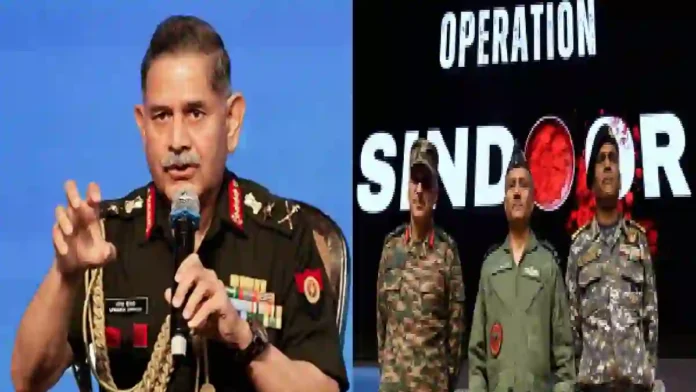The Indian Army’s adoption of SAMBHAV (Secure Army Mobile Bharat Version) during Operation Sindoor represents a watershed moment in the modernisation of military communications and India’s journey towards digital self-reliance in defence systems.
The Chief of Army Staff, General Upendra Dwivedi, while addressing the AIMA 52nd National Management Convention, confirmed that the indigenous ecosystem was deployed across critical levels of command and communication during the joint-force offensive launched in May 2025 against Pakistan.
This marked a significant operational shift, as the Army consciously avoided the usage of popular commercially available platforms such as WhatsApp, which, despite being encrypted, posed inherent risks of surveillance, data leaks, and foreign interception. The emphasis on SAMBHAV, integrated with 5G-ready indigenous smartphones, layered encryption, and controlled networks, illustrated a calculated response to concerns over information security and battlefield secrecy.
First introduced in January 2024, SAMBHAV was envisioned as a fully indigenous, end-to-end secure mobile ecosystem under the Atmanirbhar Bharat initiative. Designed in collaboration with leading academic institutions and industry partners, the system marries advanced telecom architecture with military-grade security frameworks.
Read- India-US Negotiations Back On Track, Trump Certain of ‘No Difficulty’ In Trade Talks
It operates independently of vulnerabilities associated with civilian mobile networks by leveraging encryption protocols at multiple levels, effectively creating a network-agnostic but secure channel of command and control.
This agility was critical in Operation Sindoor, where rapid, real-time communication between commanders and units was required during both conventional manoeuvres and precision strike missions. General Dwivedi pointed out that the Army is embracing spiral development, upgrading SAMBHAV continuously to meet emerging challenges in cyber warfare and electronic intelligence.
At the user level, SAMBHAV features M-Sigma, an indigenous encrypted communication app engineered as the secure counterpart to WhatsApp. It enables officers to exchange documents, maps, intelligence images, and multimedia securely without exposure to interception or data compromise.
The platform’s architecture also integrates multi-tier authentication, indigenous SIM profiles, and hardened device firmware, reinforcing its resilience even under hostile attempts at jamming or spoofing.
From the operational perspective, the system delivered commanders assured connectivity in forward areas, enabling them to issue mission updates, coordinate surveillance drone feeds, and synchronise fire missions without external reliance.
Read- ‘In India, Land Will Remain Currency of Victory’: Army Chief General Upendra Dwivedi
Read- Su-30 Undergoes 100 HAL-Driven Modifications, BrahMos Integration A Key Milestone: HAL CEO
According to defence officials, the Army views SAMBHAV not only as a telephone replacement but as the foundation of an integrated tactical communication ecosystem, future-proofed for Artificial Intelligence (AI)-enabled data processing and drone-human team networking.
Operational accounts emerging from Operation Sindoor highlight that SAMBHAV significantly streamlined the decision cycle within combat operations.
With soldiers and officers linked on a secure ecosystem, the Army maintained a unified across-the-ranks communication chain in real time. Senior commanders emphasised that undoing dependence on vulnerable commercial apps was not merely symbolic but a necessity amid digital and electronic warfare threats from adversaries.
The adoption of SAMBHAV allowed India to outpace adversarial monitoring, ensuring that sensitive data, strike orders, and surveillance intelligence remained within indigenous, encrypted ecosystems. Beyond its tactical role, the Army viewed SAMBHAV as an articulation of the nation’s ability to create sovereign technologies rooted in the Atmanirbhar Bharat vision.
The system’s deployment is not limited to Pakistan-centric operations. Defence reports make it clear that SAMBHAV handsets were already in use during the October military dialogue with China, serving as secure diplomatic-military communication devices. Such usage demonstrates the scalability of the platform from theatre-level operations to sensitive border negotiations.
As of late 2025, approximately 30,000 SAMBHAV devices have been distributed across the force, representing a phased rollout within officer cadres before eventual extension to other ranks. The programme underscores the Army’s broader roadmap of building redundant and sovereign command, control, communications, computers, intelligence, surveillance, and reconnaissance (C4ISR) frameworks.
Looking forward, the Army has confirmed ongoing upgrades of SAMBHAV to a higher security and performance tier, including compatibility with emerging military 5G private networks, satellite uplinks, and encrypted cloud services. By aligning the smartphone ecosystem with drone control apps, field sensor feeds, and AI-enabled predictive logistics, SAMBHAV is poised to serve as the backbone of India’s digitally networked battlefield architecture.
Operation Sindoor effectively validated this system under combat conditions, demonstrating not only its resilience but also its role in redefining India’s counter-terrorism doctrine.
The emphasis on blending human soldiers with “bots,” as General Dwivedi stressed, situates SAMBHAV as more than a communication tool: it is the launchpad for a comprehensive digital doctrine that will underpin India’s preparedness for future asymmetric, high-tech conflicts.
Based On ET News Report
Agencies




